Minimalist design has moved beyond interior design into the garden. In recent years, glossy lifestyle magazines have featured pristine interiors composed of carefully chosen decoration, blank walls, functional furniture with clear work surfaces and no clutter.
But the concept of the minimalist garden follows the ideas of the modernist architecture of the 20th century, when concrete and glass buildings required an unadorned surrounding landscape, and also takes leads from the Zen gardens of Japan.
Minimalist gardens have become popular with those who prefer order, with simple lines and restrictive planting, combined with the benefits of low maintenance.
Let's look more closely at some of the common themes found in minimalist garden design — the use of space, pristine hardscaping, restrictive planting and formal water features.
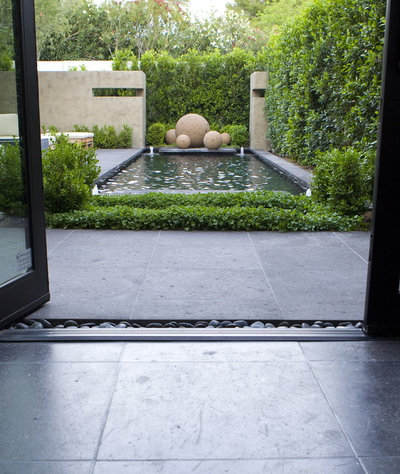
BERGHOFF DESIGN GROUP
A Doorway to MinimalismThe introduction of the "rooms outside" style of garden design in the 1960s led us to view smaller gardens in a different way. Rather than a separate part of the property, the garden became an extension of the house.
The introduction of patio doors with large areas of glass, and later, bifold doors that peel back to remove any barrier between the interior and exterior, has forged the way for the creation of the minimal garden.
By using the same flooring material inside and out a smooth transition is created between the spaces.
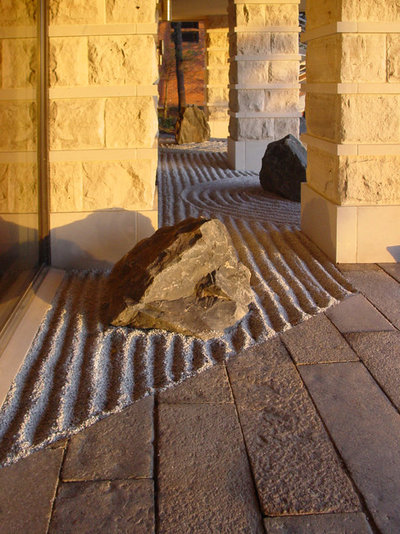
For the real source of minimalism, we should look to the Zen gardens of Japan. The perfectly placed rocks set in immaculate gravel, raked into swirling patterns, are pure minimalism.
Japanese gardens were created in the pursuit of spirital balance, but in the West this has become a garden style.
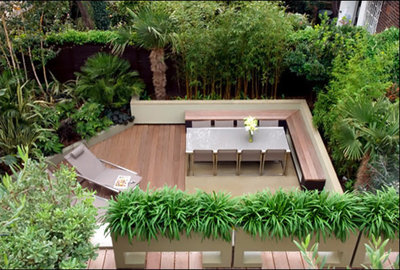
MyLandscapes
The Use of Space Space is possibly more important in a minimalist layout than any of the individual defined features. The balance between the areas or zones is vital in creating oneness with the complete design, and nothing should be allowed to distract from the creation of minimalistic perfection.
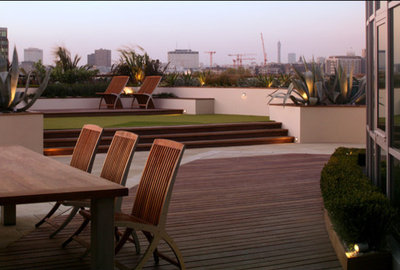
MyLandscapes
This beautiful example of a modern minimalst garden, by London garden designer Amir Schlezinger, brings together the main features we have come to expect from this type of design.
The design is formal and simple, maintenance is low, there is little or no ornamentation and planting is restricted. Each area of the garden is well defined, be it the dining zone or relaxing/sunbathing area.
The weed-free and manicured lawn is elegantly simple and perfectly level, with crisp edges.
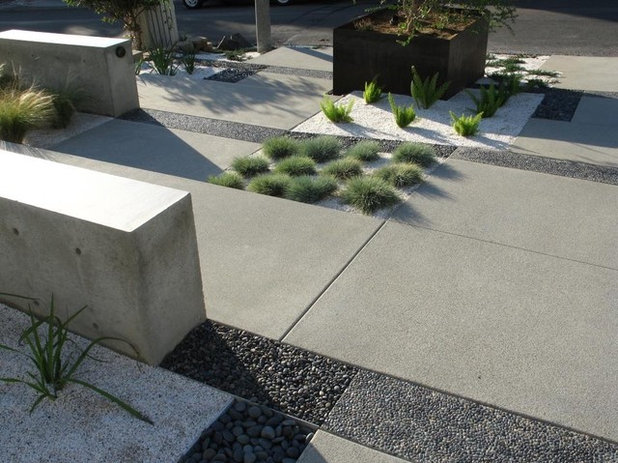
Grounded - Richard Risner RLA, ASLA
Striving for Paving PerfectionPaving in minimalist gardens needs to be simple and straightforward, yet highly engineered. The materials used need to be immaculate in finish — limestone or pale sandstone are favorites used by designers, though polished concrete also fits the bill.
Though any minimalist garden should be as maintenance free as possible, any hardscaping must be kept pristine to acheive the look.
Maintenance tip: Pressure washing should help keep more absorbent stone, such as limestone and sandstone, free from algae and dirt stains.
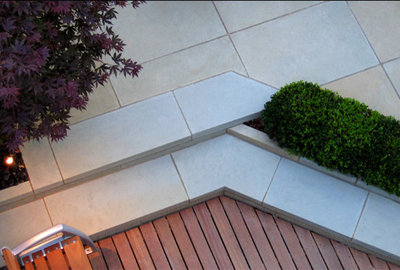
MyLandscapes
If regular pavers are used, they are generally butted with very tight joints of 3 millimeters or less. The simple planting of boxwood
('Buxus spp.') emphasizes the clear lines of the paving.
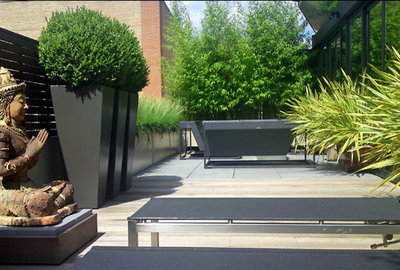
MyLandscapes
Where Fewer Plants Can Be MoreWith fewer plants used in this style of design, each plant has to be carefully chosen to perform the task required of it — be it a focal point or a visual partition. Restricting the range of plants (in this example to four species), allows the planting to soften the hardness of the design, yet not detract from the structure and line.
Maintenance tip: Plant maintenance should be simple and not time consuming. Minimize watering by adding water-retention granules to planting composts, and use an automatic irrigation system on a timer. Slow-release fertilizer pellets can turn feeding into just an annual job.
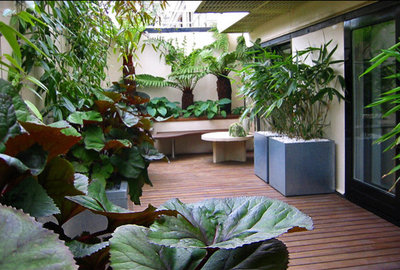
MyLandscapes
The clean lines of this deck — minimalism has brought the use of decking to the highest echelon — are complemented with the bold tropical-style planting. This could be anywhere in warmer climes, but this courtyard is set on the banks of the River Thames in London.
The plants have been carefully selected to give the feeling required. Hostas, Ligularias, bamboos and tree ferns have all been planted in repetitive groups.
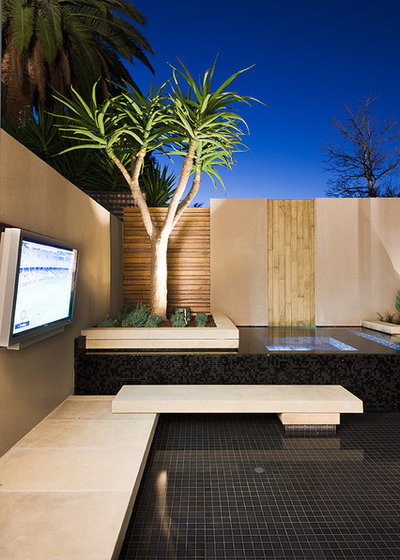
C.O.S Design
Creating a Reflective AtmosphereWater features can alter the mood of this style, which can be rather sterile or austere. A reflective pool can help achieve a calming atmosphere, while the soothing sound of a contemporary waterfall or fountain brings a further dimension.
The size of any water feature should be kept in scale with the space and fit into the set geometry — most minimalist water features are formal.
The asymmetrical formality of the design shown here is built around the tiled mosaic pool, linking all spatial areas of the garden.
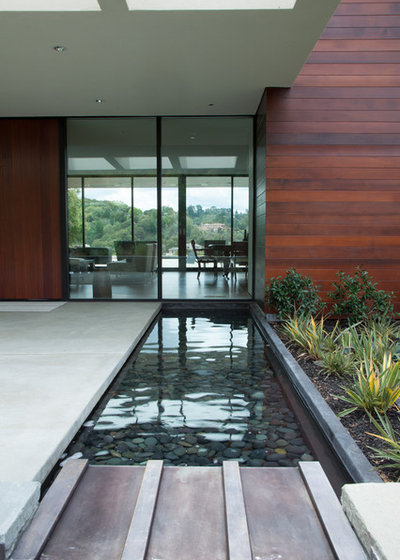
Thuilot Associates
This extended pool seems to flow out of the house, its reflective surface echoing the shine on the interior floor.
The pebble floor of this pond gives extra texture to the design, yet a pure black reflective surface could have been achieved with black pond dye added to the water. This also would have the benefit of blocking light, which would help prevent the growth of algae and keep the pond in the spotless state demanded of minimalist design.
Any water feature used in minimalist designs must be perfect in construction and maintenance, and care must taken with water levels, pond hygiene and even the disguising of any pond lining.
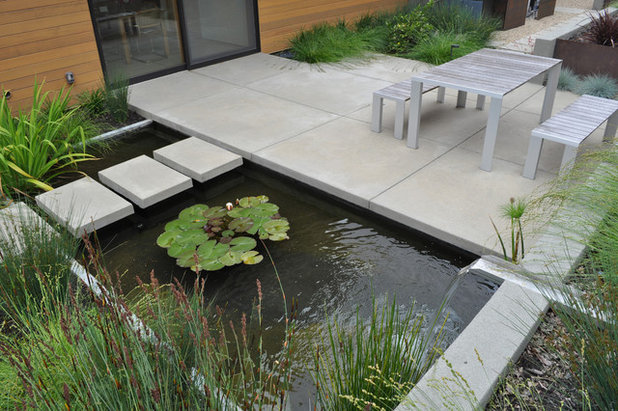
Huettl Landscape Architecture
This garden really sums up the ethos of how to create a minimalist design you can live with.
The space is clear and obvious with a generous dining area set on immaculate paving floating over a deep refective pool. The plantings are simple, repetitive and easily maintained.
More:Give Your Small Garden Some Room
Lay of the Landscape: Modern Garden Style





